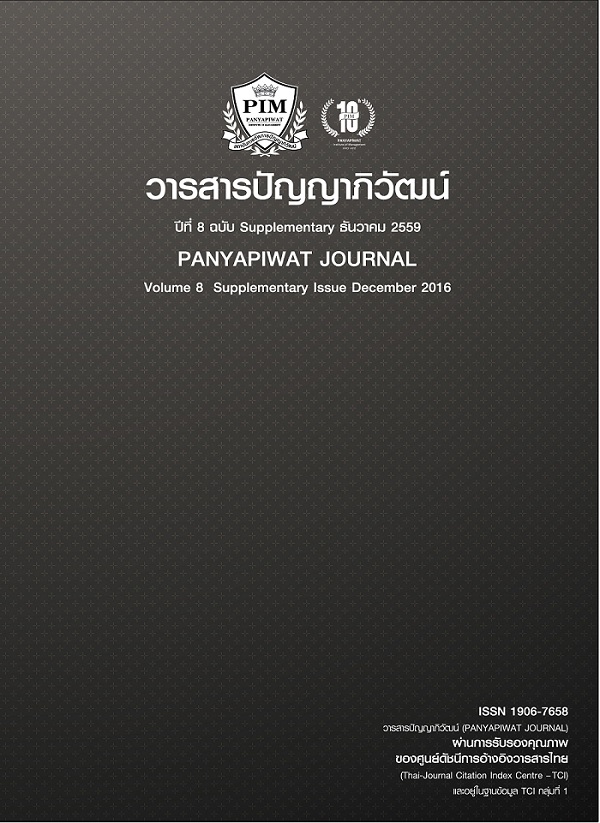INTEGRATED MANAGEMENT MODEL FOR DAY SPAS BUSINESS IN THAILAND
Main Article Content
บทคัดย่อ
The objectives of this research were to study the contexts and vital elements of day spa management in Thailand in order to develop an integrated management model for day spas business in Thailand. The academic gathered of both qualitative and quantitative research methodologies, through a sample of six individuals’ staff involved in the day spa business in Thailand; which are managers, receptionists and therapists, as well as 400 customers using day spas in Thailand. The research tools were an interview script and questionnaires based on theorems and principles regarding value chain management, product management, quality management, human resources management, supply chain management and marketing. The interview results shown that the theories used as the foundation of this research are applicable. Further data from the survey were processed for descriptive statistics which included frequencies, percentage, mean, standard deviation and correlation. The studied results showed that the most concerned element is sales & marketing followed by supply chain management, human resource management, quality management and products management, respectively. The correlation coefficients between all of the studied elements were positive correlation.
การวิจัยครั้งนี้มีวัตถุประสงค์เพื่อศึกษาบริบทและองค์ประกอบที่สำคัญของการบริหารธุรกิจเดย์สปาในประเทศไทย ทั้งนี้เพื่อใช้ในการพัฒนารูปแบบการบริหารแบบบูรณาการของธุรกิจเดย์สปาในประเทศไทย ผู้วิจัยรวบรวมข้อมูลโดยใช้ระเบียบวิธีวิจัยเชิงคุณภาพและปริมาณ จากกลุ่มตัวอย่างพนักงานของเดย์สปาในประเทศไทยในตำแหน่งผู้จัดการ พนักงานต้อนรับ และพนักงานให้บริการนวด จำนวน 6 ท่าน และ ผู้ใช้บริการเดย์สปาในประเทศไทย จำนวน 400 ราย เครื่องมือวิจัยที่ใช้คือบทสัมภาษณ์และแบบสอบถามที่ใช้ฐานข้อมูลจากทฤษฎีและหลักการที่เกี่ยวเนื่องกับการบริหารห่วงโซ่คุณค่า การบริหารผลิตภัณฑ์ การบริหารคุณภาพ การบริหารทรัพยากรมนุษย์ การบริหารห่วงโช่อุปทานและการตลาด ผลจากการสัมภาษณ์แสดงว่าทฤษฎีต่างๆ ที่ใช้เป็นพื้นฐานในการศึกษาสามารถนำมาปรับใช้ได้ สถิติที่ใช้ในการวิเคราะห์ข้อมูลคือ สถิติเชิงพรรณา ประกอบด้วยความถี่ ร้อยละ ค่าเฉลี่ย ส่วนเบี่ยงเบนมาตรฐาน และสหสัมพันธ์ ผลการศึกษาพบว่าผู้ตอบแบบสอบถามให้ความสำคัญกับองค์ประกอบในด้านการบริหารการตลาดสูงสุด ตามด้วยการบริหารห่วงโซ่อุปทาน การบริหารทรัพยากรมนุษย์ การบริหารคุณภาพ และการบริหารผลิตภัณฑ์ ตามลำดับ ค่าสัมประสิทธิ์สหสัมพันธ์ระหว่างทุกองค์ประกอบที่ศึกษาเป็นสหสัมพันธ์ทางบวก
Article Details
“ข้าพเจ้าและผู้เขียนร่วม (ถ้ามี) ขอรับรองว่า บทความที่เสนอมานี้ยังไม่เคยได้รับการตีพิมพ์และไม่ได้อยู่ระหว่างกระบวนการพิจารณาลงตีพิมพ์ในวารสารหรือแหล่งเผยแพร่อื่นใด ข้าพเจ้าและผู้เขียนร่วมยอมรับหลักเกณฑ์การพิจารณาต้นฉบับ ทั้งยินยอมให้กองบรรณาธิการมีสิทธิ์พิจารณาและตรวจแก้ต้นฉบับได้ตามที่เห็นสมควร พร้อมนี้ขอมอบลิขสิทธิ์บทความที่ได้รับการตีพิมพ์ให้แก่สถาบันการจัดการปัญญาภิวัฒน์หากมีการฟ้องร้องเรื่องการละเมิดลิขสิทธิ์เกี่ยวกับภาพ กราฟ ข้อความส่วนใดส่วนหนึ่งและ/หรือข้อคิดเห็นที่ปรากฏในบทความข้าพเจ้าและผู้เขียนร่วมยินยอมรับผิดชอบแต่เพียงฝ่ายเดียว”
References
Bateman, T. S. & Snell, S. A. (2007). Management: Leading & collaborating in a competitive world(7th ed.). New York: McGraw-Hill.
Baxter, L. A. & Babbie, E. (2004). The Basics of Communication Research. California: Thomson.
Boehnke, K., Lietz, P., Schreier, M. & Wilhem, A. (2011). Cross-cultural research methods in psychology. Cambridge: Cambridge University.
Chain Conveyor Design. (2011). Porter’s value chain. Retrieved April 6, 2013, from http://www.chainconveyordesign.net/wp-content/uploads/2011/11/Porters-Value-Chain.jpg
Cohen, M. & Bodeker, G. (2008). Understanding the global spa industry. Massachusetts: Elsevier.
Department of Business Development. (2013). Strategic business plan. Nonthaburi: Department of Industrial Promotion.
Department of Tourism. (2010). International tourist arrivals to Thailand. Retrieved February 5, 2015, from http://tourism.go.th/2010/th/statistic/tourism.php?cid=30
Drummond, G. & Enson, J. (2005). Introduction to marketing concepts. Massachusetts: Elsevier.
Federoff, P. (2011). Comparing service quality performance with customer service quality need: Explanation of SERVQUAL methodology of Zeithaml, Parasuraman and Berry. Retrieved December 31, 2012, from http://www.12manage.com/methods_zeithaml_serqual.html
Heizer, J. & Render, B. (2010). Operations management (11th ed.). New Jersey: Pearson.
Henwood, K. & Pidgeon, N. (2006). Research methods in psychology (3rd ed.). London: SAGE.
Hoyle, D. (2007). Quality management essentials. Oxford: Butterworth-Heinemann.
International Spa Association (ISPA). (2006). State of spa industry. Retrieved February 11, 2015, from http://www.experienceispa.com
Johnston, K., Puczko, L., Smith, M. & Ellis, S. (2011). Global spa summit. Colorado: Global Spa Summit.
Kotler, P. & Armstrong, G. (2012). Principles of Marketing (14th ed.). New Jersey: Pearson.
Kotler, P., Bowen, J. & Makens, J. (2006). Marketing for hospitality and tourism (4th ed.). New Jersey: Pearson.
Leedy, P. D. & Ormrod, J. E. (2005). Practical Research: Planning and Design (8thed.). New Jersey: Pearson.
Marczyk, G., De Matteo, D. & Festinger, D. (2005). Essentials of Research Design and Methodology. New Jersey: John Wiley & Sons.
Ministry of Public Health (MOPH), Thailand. (2012). Manual of spa business. Retrieved December 21, 2013, from http://pmsm.hss.moph.go.th/uploadFiles/document/D00000000403_23745.pdf
Office of Small and Medium Enterprises Promotion. (2015). Strategic planning for small and medium enterprises. Retrieved February 14, 2015, from http://www.sme.go.th/SiteCollectionDocuments
Provincial Public Health Office of Phuket. (2012). Telephone Interview. December 20, 2012.
SCI QUAL International. (2015). What is an integrated management system (IMS). Retrieved February 20, 2015, from http://www.sciqual.com.au/what-integrated-management-system-ims
Yamanae, T. (1973). Statistics: an introductory analysis. New York: Harper & Row.

